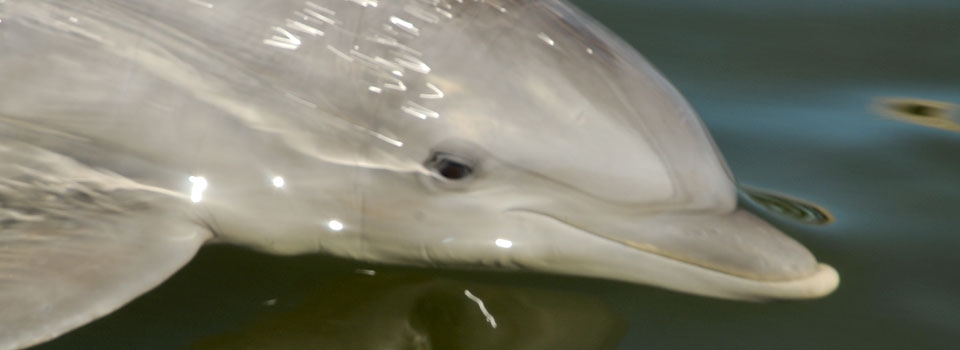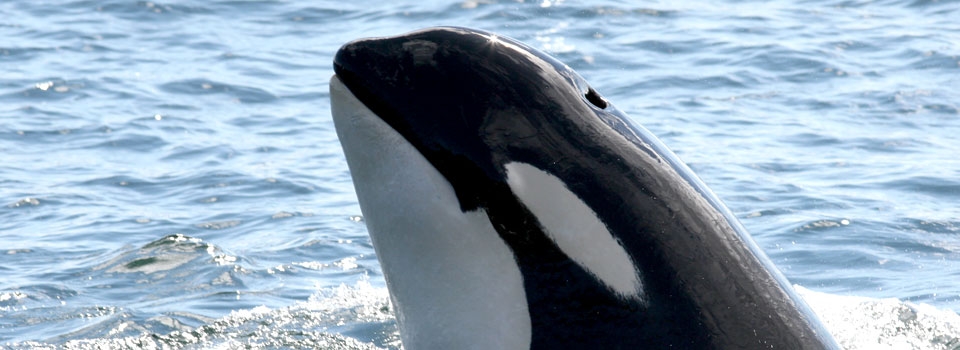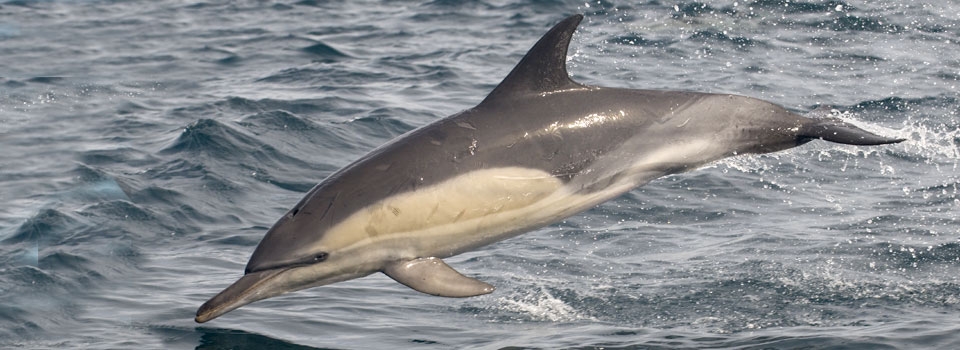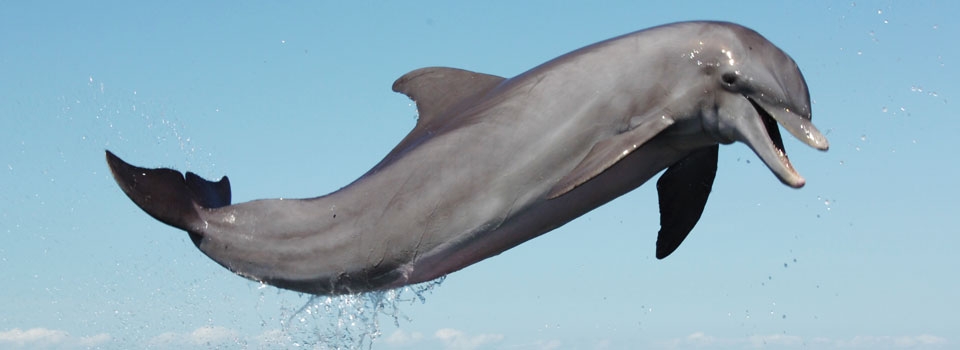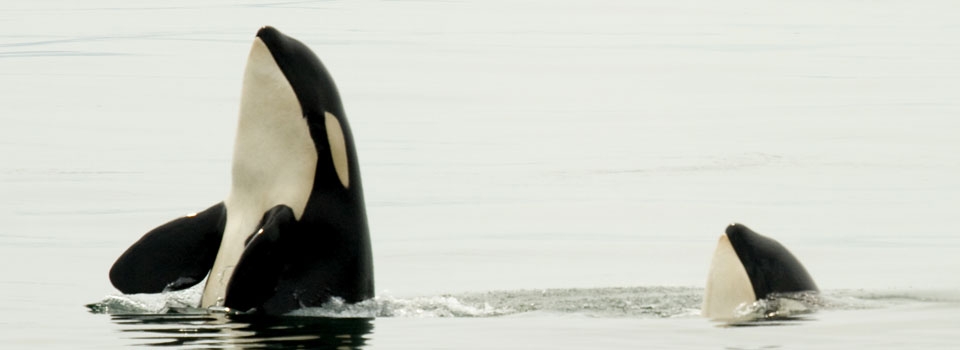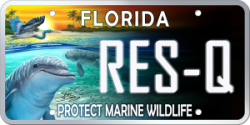- RESEARCH
- LEARN
- Child Education »
- Teen Education »
- Adult Education »
- Resources »
- Kids Zone »
- SHOP

- Providing Sanctuary and a Forever Home since 1984.
- A not-for-profit 501(c)3 marine mammal education and research facility for more than 35 years.
- Providing Sanctuary and a Forever Home since 1984.
A not-for-profit 501(c)3 marine mammal education and research facility for more than 35 years.
Introduction
Introduction
The scientific infraorder Cetacea includes the whales, dolphins, and porpoises. These aquatic creatures are the most specialized of all mammals, with adaptations that allow them to spend their entire lives in water. Living cetaceans are divided into two distinct suborders, Mysticeti and Odontoceti, which are divided further into a total of fourteen families. The Mysticeti suborder contains those whales which have baleen plates instead of teeth. A baleen whale feeds by straining water through the baleen, trapping the fish, shrimp, crustaceans, or krill inside its mouth. This suborder is comprised of the largest whale species, including the blue whale, the humpback whale, and the grey whale.
Those cetaceans classified in the suborder Odontoceti are toothed whales, dolphins, and porpoises. They are generally smaller, faster, and more agile than their baleen counterparts. Scientists have identified approximately 84 species of toothed whales, ranging in size from the 60-foot sperm whale to the five-foot harbor porpoise. The various species are incredibly diverse and display a multitude of body shapes, behavior patterns, and lifestyles. Some spend barely any time on the surface, rising occasionally to take a breath; others can leap 20 feet out of the water almost effortlessly. Some species live in the shallows close to shore, some reside in deep oceans, and still others are found only in fresh water rivers. Odontoceti may have anywhere from eight to 250 teeth (Reynolds 1999), and their eyesight ranges from poor to excellent.
Delphinidae is the largest family within the Odontoceti suborder. Scientists have discovered fossil records of ancient delphinids, which date back 11 million years. This family is composed of what we commonly call dolphins. There are over 30 different species in this family, the largest of which is the Orca, or killer whale. Delphinids are characterized by sharp, cone-shaped teeth; most (but not all) possess a falcate dorsal fin and a melon joined to a distinct beak.
If you're lucky enough to briefly spy a delphinid in its natural habitat, you may get a glimpse of a torpedo-shaped body darting smoothly through the waves, perhaps catching a free ride from the wake of your boat or peering inquisitively at you from the depths of its dark, soulful eyes. You might observe a group off in the distance, leaping high into the air or porpoising swiftly as they travel together in their search for food.
Sights such as these have moved mankind throughout our history, serving to increase our curiosity about the dolphins which share our world. Pictures of dolphins appeared in art forms as early as 1500 BC, and even the great Greek philosopher Aristotle (384-322 BC) told stories of dolphins interacting with people and described them as mammals. Our fascination with dolphins continues today, and is evident in the work of many modern artists.
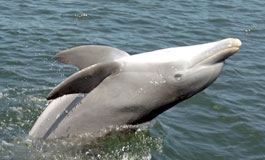
The Bottlenose Dolphin
The Bottlenose Dolphin
The common bottlenose dolphin, whose scientific name is Tursiops truncatus, is probably the dolphin most familiar to the general population because of its adaptability of living in human care. Bottlenose dolphins can be seen in various show and research facilities and have been the "stars" of many movies and television shows. Because of their seeming curiosity about people and their close proximity to various shores and ocean bays, this species is the most studied of all delphinids. The bottlenose is the dolphin most often sighted off the coast and from small boats. In some places in the world, such as Monkey Mia in Australia, wild bottlenose dolphins are provisioned with food to come into bays and interact with human beings.
Bottlenose dolphins are the largest of the beaked dolphins. There is a definite crease where the rostrum (snout or beak) joins the melon. Their bodies are dark gray on the back and sides, fading to a pinkish white belly underneath. Their dorsal fins are often falcate, curving slightly to the back. Pectoral fins and flukes are pointed at the tips. Atlantic common bottlenose dolphins are usually 6 to 9 feet long at maturity (Reynolds 2000); the Pacific variety often may be larger. The largest member of the entire family Delphinidae is the Orca, better known as the killer whale.
Range
The exact number of the world population of bottlenose dolphins is unknown. They are found world-wide and in many types of waters from coastal and inshore waters to the pelagic waters of the deep oceans, from warm tropical waters around the equator to the colder temperate regions. In general, bottlenose dolphins can be found in all coastal waters throughout the world, except for the polar seas.
In the Pacific Ocean, bottlenose dolphins range from northern Japan to southern Australia and New Zealand, and from southern California down to the coast of Chile. Populations located in the inshore waters of New Guinea and northern Australia often share their range with the Indo-Pacific humpback dolphin, while offshore populations are often seen associating with pilot whales.
In the Atlantic Ocean, bottlenose may be found from Nova Scotia to Norway, extending south to Argentina and the southern tip of South Africa. In the west Atlantic, including both Hudson Bay and the Caribbean Sea, bottlenose dolphins are fairly widespread. Abundant populations are located in Florida's coastal waters and in the Gulf of Mexico. Less commonly, they may be found off the Virginia coast and in Chesapeake Bay. Many offshore populations in the Atlantic coexist with pods of pilot whales or other species. Although bottlenose dolphins were once commonly seen in the coastal waters of the northeast Atlantic, populations along the English Channel coasts seem to have declined. Some offshore groups can still be found, and others exist in bays and estuaries, particularly along the coast of western Ireland.
Bottlenose dolphins are also common throughout the Indian Ocean from the coasts of India and Sri Lanka to the southern tips of South Africa and New Zealand. Both inshore and deep water, pelagic populations are well known throughout this area, including the Mediterranean Sea, the Persian Gulf, and the Red and Black Seas. The bottlenose dolphin seems to be one of the most abundant species found in Israeli waters and along the Egyptian coast.
We are far from knowing the precise ranges of the various populations of bottlenose dolphins around the world, especially those who live far from shore. Most, however, seem to prefer a relatively small area within a protected bay or shallow lagoon. They seem to establish a "home base," but must often move within a larger range to find food, to mate, or to escape predators.
Scientists have found that small pods of bottlenose dolphins near San Diego, California seem to have a range of approximately 20 miles along the coastline. When Randy Wells studied bottlenose off Sarasota, Florida, he found that local populations had a range of about 85 square kilometers, with individuals defining smaller home ranges for themselves. He found that distances traveled varied by sex and age of the dolphins: females with calves seemed to have the largest home range (average 40 square km); juvenile males tended to establish a somewhat smaller one; adult male groups, adult females without calves, and juvenile females had the smallest ranges of approximately 15-20 square km. Each subrange of the larger pods was centered in different areas, possibly due to the fact that dolphin pods tend to be segregated by sex and age. Other studies in Argentina, Texas, and California had similar results and have promoted the theory that social units of like sex and age tend to define the home ranges of various pods.
Feeding
Most Odontoceti (toothed whales) feed on various types of fish or squid, although the Orca also will prey upon birds and other marine mammals, often many times larger than itself. The various species of toothed whales have long rows of sharp teeth, suitable for grasping quick-moving prey such as fish and squid. They do not chew their food, but swallow it whole, using muscles at the back of their tongue and throat to squeeze the salt water out and the fish down. The preferred food of a particular species or stock depends on its physiological feeding apparatus, the ecology of the area in which it is located (water temperature, terrain, depth), and the feeding behaviors practiced by that group.
Diet may indirectly determine the size of a pod. For example, the largest toothed whale, the sperm whale, feeds on giant squid of over 12 meters in length which are found at great depths and do not occur in large numbers. Sperm whales may travel individually or with only one or two other whales to facilitate finding enough food. An average pod of pelagic dolphins that eat small squid usually numbers less than 100, depending on the concentration of squid in any particular area. The common, spinner and spotted dolphins feed on shoaling fish and may travel in pods numbering in the thousands.
The natural diet of the bottlenose dolphin seems to vary according to its home region. Open water pods tend to feed mostly on pelagic fish, such as blue whiting, cod fish, and squid. Those found in coastal Atlantic waters feed on mullet, herring, smelt, capelin, catfish, eels, shrimp, and other crustaceans. In the Indian Ocean, dolphins will be more likely to feed on coral reef dwelling fish and mullet. Haddock, anchovies, and mackerel also seem to be favorites of some populations.
Dolphins usually forage for food in groups. Because fish tend to be distributed throughout their range in ever-moving schools, they must search for their prey. If they remained in only one small area constantly, they would soon exhaust the available food supply; therefore, they tend to leave and then revisit various feeding grounds on a periodic basis. By hunting cooperatively in groups, dolphins can cover a wider area and combine their collective experience. Knowledge of topographical features of the area, as well as their ability to scan the area acoustically under water, contributes to their ability to find food. Most dolphins and fish- or squid-eating small whales travel in groups which are broader than they are long, enabling them to scan a wider area with their echolocation.
In the waters of South Africa, researchers have observed a single line of approximately 200 bottlenose dolphins traveling quickly and cooperatively in their search for food. Based on observations of behavior such as synchronous dives and recordings of vocalizations, scientists have theorized that pods of dolphins remain in constant acoustic contact while foraging.
Bottlenose dolphins seem to work together during feeding as well as while searching for fish. Researchers have observed them using a variety of cooperative methods to entrap their prey which reduce the amount of energy expended by any individual. Small groups may converge on a central point by porpoising to that point, and then bunching fish up together in the center. Groups have been observed moving synchronously in a U-shaped formation towards other individuals, trapping the fish in between. At times, individuals may dive down and herd a school of fish upwards by swimming around and under them, tightening the circle until the fish are forced to the surface where the rest of the pod is waiting to feed.
Other, more unusual, methods also have been noted by researchers. Dolphins have been observed using a sloping, sandy beach as a barrier while herding schools of fish. In some areas, dolphins will chase fish onto mudflats, and then actually almost beach themselves by sliding out of the water to seize their prey. Dolphins in the Hilton Head area have been observed creating a barrier of bubbles to entrap their prey before feeding. Scientists have theorized that some dolphins may use a burst pulse – a stream of very powerful sounds – to stun or confuse their prey.
On the west coast of Africa, bottlenose dolphins even work cooperatively with humans to ensure their food supply. The dolphins herd mullet to the shallows where native fishermen wait with gill nets to trap the fish. The fishermen allow the dolphins to eat their fill, and then take the rest. The fishermen apparently can alert the dolphins to feeding time by slapping the water with sticks as a cue for food.
In southern Brazil, bottlenose dolphins have been the initiators of another fishing cooperative. A pod of dolphins alerts the men of Laguna to "feeding time" by stationing themselves offshore in a line. When a dolphin leaves the line, swims seaward, and returns, the men wait close to shore with their nets. When the dolphin reappears, comes to a full stop, and dives just out of net range, the fishermen closest to the dolphin cast their nets, even though the water is murky and they cannot see any fish. The cue given by the dolphins is reliable; few fishermen waste their time casting until instructed to do so by the dolphins' actions. After one or more men fill their nets, others come to take their place. If the dolphins move along the shore, the men will follow. The dolphins seem to take advantage of the confusion which results as the men cast their nets, feeding on their own from the remaining fish. Town records indicate that this partnership has lasted through several generations of both men and dolphins since 1847.
Social Structure and Behaviors
Dolphins tend to be very social animals, swimming in social groupings called pods. These groups, however, are very flexible and fluid, not at all like the social unit we refer to as a family. Dr. Deborah Duffield has determined by observing pods of wild bottlenose dolphins that the majority of pod members are not closely related. They seem to be in a periodic state of flux; an individual dolphin traveling with one group may be swimming miles away with another by the next day. A more stable subgroup of two to six dolphins may remain together over long periods. Mothers and their calves have been observed together for at least three to six years, and unrelated adults often form long-term bonds, usually within the same sex and age group (Reynolds 2000).
Separation by age and sex is common. Breeding groups are usually composed of mothers and their calves. As the youngsters begin to mature, they may branch off into a juvenile pod. Mature males will rarely be seen mixing with a maternity pod or a juvenile pod. The fluidity of the groups, however, allows increased opportunities for mating, enabling males to court a wider variety of females. During feeding, smaller pods may interact and join into larger groups. Bottlenose dolphins also have been observed swimming and feeding with other cetaceans such as sperm whales, gray whales, humpbacked dolphins, and right whales.
Although solitary individuals are sometimes seen in the wild, bottlenose dolphins usually live in pods composed of two to twenty-five dolphins. Inshore groups tend to be smaller, with an average size of ten, while offshore animals can contain groupings of hundreds of individuals. The size of the group may depend partially on the need for surveillance against predators, as well as the quantity and distribution of available food.
Dolphins seem to acknowledge a hierarchy within each pod. Status may be expressed by positioning, formation of subgroups within the pod, or by feeding order. Behaviors, such as teeth raking, tail slapping, jaw popping, biting, or ramming, may also express dominance.
Play Behavior
Dolphins have long been known for their playful characteristics. By riding the wake or bow waves of a boat, a dolphin can hitch a ride and move through the water like a surfer. Often they can be seen weaving back and forth, playing in the spray, and forming intricate patterns. Many species of dolphins are capable of spectacular aerial dives, and their leaps and spins seem to us to be a celebration of the joy of life.
However, their play behavior may also serve functions of communication, food herding, or defense. Mothers begin to play with their calves early in their development. Perhaps these sessions teach behaviors that will be important throughout their lives. Juveniles engage in courtship behaviors long before sexual maturity, chasing each other, stroking, swimming belly to belly, and touching flippers. This form of play continues into adulthood among members of the same sex as well as among individuals of opposite sex. These behaviors do not necessarily result in mating, although mating itself may be considered a form of play, as mating does not always result in conception. Dolphins are very tactile creatures and seem to express affection through such varied behaviors as raking each other with their teeth or gentle stroking.
Altruistic Behavior
Legends of dolphins rescuing men lost at sea have existed throughout the ages. Although some may have been stretched out of proportion or completely manufactured, dolphins have been known to be friendly to humans in their environment. Bottlenose dolphins also seem to evidence selfless behaviors towards other members of their pod. They often work cooperatively in groups to feed, males may assist each other in obtaining a mate, and pod mates often will support an injured dolphin at the surface so that it can breathe. Entire pods will put themselves in jeopardy to come to the aid of a mother and her calf. One theory explaining why individual dolphins do not remove themselves from a dangerous area around a fishing net is that they will not leave their comrades who are entangled or injured.
Life Span
Human beings, either directly or indirectly, seriously affect mortality rates for dolphins and other cetaceans. Stranded whales have been found with plastic bags (possibly having mistaken them for jellyfish) and other debris in their stomachs, which can cause internal injury or starvation. Chemical pollution in their waters may contaminate their food supply and has been linked to immune system suppression (making them more susceptible to disease), reproductive failure, and other damage. Certain fishing methods cause dolphin deaths incidentally, and in some areas of the world, dolphins and whales are still hunted. Natural death, however, usually results from one of three main causes: predators, parasites, or disease. Aside from man, Orcas and sharks comprise the largest threats as predators to bottlenose dolphins in their natural environment. Nematodes, tapeworms, and parasitic flukes have been found to infest their internal organs. Bacterial and viral infections are not uncommon, and studies have shown that they may account for over one-fourth of marine mammals found stranded or dead. Life in the ocean is not an idyllic paradise; many marine mammals killed in fisheries or in strandings are found to have ulcers believed to be stress-related.
Like all animals in the wild, dolphins are most susceptible to adverse conditions, disease, and predators during the first two years of their lives. A study of beached dolphins in Florida indicated that 38% died before the age of two, and 64% of the dolphins studied died within their first ten years (Reynolds 2000). Although, rare, it is possible for bottlenose dolphins to live into their 50s. This is similar to the average human life span being 77, but some people living into their late nineties or beyond. Scientists have found that dolphins living in human care have approximately the same longevity as those in the wild, possibly even better because of improved nutrition, a reliable food source, and the optimum husbandry and medical care made possible by our growing knowledge (Innes 2005).
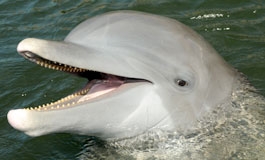
Other Delphinidae Species
A Sampling of other Delphinidae Species
Orca or Killer Whale
Scientific Name: (Orcinus orca)
The Orca is the largest of all delphinids and can reach up to eight or nine meters in length and weigh up to ten tons. Its jet black body is patterned with pure white patches: a small elliptical patch is located behind the eye; a second covers the lower jaw, throat, and stomach, terminating in prongs which extend up and back on the tail; another is a gray "saddle" patch located behind the dorsal fin which is distinctively shaped on each animal. The tall, black dorsal fin is easily recognizable. On males, it will be straight and up to 1.8 meters (Reeves 2002) tall; females' dorsals are approximately half that size with a slight falcate curve.
Orcas have a complex social structure, which is apparently matriarchal in nature. Unlike other toothed whales, both daughters and sons stay with their mothers for most of their lives. Once the daughters have offspring of their own (little is known about mating of this species), they may form subpods, continuing to stay in close proximity to the maternal group. They travel most commonly in pods of two to twenty-five, and often hunt cooperatively. They may hunt prey much larger than themselves, such as the blue whale, but also feed on smaller whales, seabirds, turtles, fish, dolphins, porpoises, sea lions, and seals, depending on availability. Orcas are found in temperate and polar waters, both coastal and offshore. Although there are no estimates on total population, they now seem to be abundant worldwide.
For a long time, the fierce hunting habits of some populations of Orcas gave them a bad reputation as ruthless predators. Due to this unsympathetic image and the fact that fishermen considered salmon-eating pods of Orcas a nuisance, Orcas often were ruthlessly killed, until public awareness began to be raised in the 1960s. An orca harpooned off the coast of British Columbia in 1964 survived the ordeal and gave people a chance to learn of the animal's charm and intelligence, moderating the species' killer reputation. Canadian and American legislation passed in the early 1970s provided protection for these populations.
Spotted Dolphin
Scientific Name: (Stenella attenuata and S. frontalis)
A long, slender body and beak characterize this species (generally considered to have at least two forms, distinguished by range). The spotted dolphin's back is dark gray, contrasting with its light gray underbelly and sides. Dark gray patches may also occur around the eyes and on the beak. The amount of spotting varies with age as well as geographical location (Ridgway 1985). Calves are born without spots; the spots begin to develop first on the stomach, then on the back, growing in size and number as the animal matures. Spotted dolphins are a relatively small species, growing to a maximum length of approximately 2.5 meters (Reynolds 1985).
Spotted dolphins tend to travel in large pods, which may number in the thousands. They are fast, agile swimmers and have been observed leaping to great heights, doing forward flips, and riding the wakes of boats. They are found in tropical, sub-tropical and warm temperate regions around the world, sometimes in coastal waters but mainly in open ocean, and feed mostly on squid, mackerel, and flying fish.
Because of their habit of swimming with yellow-fin tuna in the Eastern Tropical Pacific, spotted dolphins have been killed by the thousands as incidental catches in purse-seine nets. Due to public pressure and subsequent changes in policy by major tuna companies in recent years, many tuna fishing fleets worked to reduce incidental bycatch of these dolphins. Thousands are still taken each year by drive fisheries in Japan, in the Solomon Islands, and by subsistence fisheries throughout the world.
Pilot Whale
Scientific Name: (Globicephala macrorhynchus and G. melas-melaena)
The short-finned variety is found most often in tropical and sub-tropical areas, while the long-finned pilot whale seems to prefer more temperate and sub-polar waters and is essentially a deep ocean species. Pilot whales feed mostly on squid and octopus; however, they will also feed on schooling fish when more readily available. They have a complex social organization and usually live in pods ranging in size from ten to a hundred. They have often been observed interacting with other species.
Pilot whales can be recognized by their large bulbous heads and black-gray bodies. Some stocks may have lighter gray patches around the eyes, on the throat or chest, or behind the dorsal. Their dorsal fins are low and rounded. The size of this species varies widely according to location; maximum length may be from 4 to 7 meters.
Although pilot whales are notorious for stranding in large groups, no one knows exactly why they do it. They are vulnerable to shore-drive hunting, and in the Faroe Islands an average of 1500 long-finned pilot whales are killed each year in a traditional hunt.
Risso's Dolphin
Scientific Name: (Grampus griseus)
The Risso's dolphin's blunt, squarish head shape, indistinct beak, and characteristic white scarring characterize this species (Reeves et al 2002). Although these dolphins are dark gray in color, their skin scars easily; older adults' bodies may appear almost white due to extensive scarring from the teeth-raking of other Risso's dolphins during play, mating, or aggressive confrontations. Their fins are slender and long, yet their bodies are stocky and range in length from 3 to 4 meters for adults (Reeves et al 2002).
Risso's dolphins are found mostly in deep water in tropical and warm temperate regions. Their pods are usually small, approximately a dozen or so, but they occasionally have been seen in large herds of several thousand. Squid seems to be their major prey, although they also will hunt fish and other cephalopods.
Common Dolphin
Scientific Name: (Delphinus delphis)
The common dolphin has been perhaps the most celebrated dolphin, depicted often in art throughout history since the time of the ancient Greeks. They have small, streamlined bodies, averaging about 2.5 meters (Wynne 1999), and long, slender beaks. Their coloring is most distinctive: the back is black to the middle of the tail stock; the flanks display an hourglass pattern of yellowish ochre and light gray, blending to grayish white along the sides of the tail. The rostrum is dark brown to black, and a narrow, dark stripe runs from the rostrum to the area surrounding the eyes.
Common dolphins are often described as acrobats because of their frequent leaps and somersaults into the air. They travel in pods of up to several thousand, and although they may split up into smaller groups to feed, they are known for being efficient cooperative hunters. Common dolphins feed mostly on squid, sardines, anchovies, and herring. This species lives in warm temperate and tropical waters around the world and may be found in both coastal and pelagic waters. They are probably the most abundant species of delphinids throughout the world; however, some stocks have been depleted to the point of risk because of the activities of fisheries in the Black Sea, off the coast of west Africa, and in the Eastern Tropical Pacific.
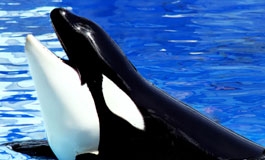
Family: Delphinidae
Family: Delphinidae
|
Genus: |
Species: |
|
Cephalorhynchus |
|
|
Black Dolphin |
C. eutropia |
|
Chilean Dolphin |
C. eutropia |
|
Commerson's Dolphin |
C. commersonii |
|
Heaviside's Dolphin |
C. heavisidii |
|
Hector's Dolphin |
C. hectori |
|
|
|
|
Delphinus |
|
|
Common Dolphin |
D. delphis |
|
Feresa |
|
|
Pygmy Killer Whale |
F. attenuata |
|
Globicephala |
|
|
Long-finned Pilot Whale |
G. melas-melaena |
|
Short-finned Pilot Whale |
G. macrorhynchus |
|
Grampus |
|
|
Risso's Dolphin |
G. griseus |
|
Lagenodelphis |
|
|
Fraser's Dolphin |
L. hosei |
|
Lagenorhynchus |
|
|
Atlantic White-sided Dolphin |
L. acutus |
|
Dusky Dolphin |
L. obscurus |
|
Hourglass Dolphin |
L. cruciger |
|
Pacific White-sided Dolphin |
L. obliquidens |
|
Peale's Dolphin |
L. australis |
|
White-beaked Dolphin |
L. albirostris |
|
Lissodelphis |
|
|
Northern Right Whale Dolphin |
L. borealis |
|
Southern Right Whale Dolphin |
L. peronii |
|
Orcaella |
|
|
Irrawaddy Dolphin |
O. brevirostris |
|
Orcinus |
|
|
Orca (Killer Whale) |
O. orca |
|
Peponocephala |
|
|
Melon-headed Whale |
P. electra |
|
Pseudorca |
|
|
False Killer Whale |
P. crassidens |
|
Sousa |
|
|
Atlantic Humpbacked Dolphin |
S. teuszii |
|
Indo-Pacific Humpbacked Dolphin |
S. chinensis |
|
Stenella |
|
|
Short-snouted Spinner Dolphin |
S. clymene |
|
Long-snouted Spinner Dolphin |
S. longirostris |
|
Pan-Tropical Spotted Dolphin |
S. attenuata |
|
Atlantic Spotted Dolphin |
S. frontalis |
|
Striped Dolphin |
S. coeruleoalba |
|
Steno |
|
|
Rough-toothed Dolphin |
Steno bredanensis |
|
Sotalia |
|
|
Tucuxi |
S. fluviatilis |
|
Tursiops |
|
|
Bottlenose Dolphin |
Tursiops truncatus |
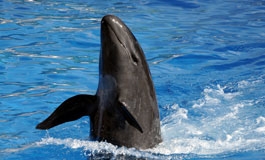
References
References
Andersen, Harold T. 1969. The Biology of Marine Mammals.Academic Press, Inc.: New York, NY.
Berta, A. and J.L. Sumich. 1999. Marine Mammals: Evolutionary Biology. Academic Press: San Diego, CA.
Bonner, W. Nigel. 1980. Whales. Blandford Press: Dorset, England.
Bryden, M. M., and Richard Harrison. 1986. Research on Dolphins.Oxford University Press: Walton Street, Oxford OX2 6DP.
Bryden, M.M. and Peter Corkeron. "Intelligence". pg. 160-165. In Whales, Dolphins and Porpoises.Ed. Sir Richard Harrison & Dr. M.M. Bryden. Facts On File Publications: New York, New York
Coffey, D. J. 1977. The Encyclopedia of Sea Mammals. Hart-Davis, MacGibbon Ltd.: London, England.
Connor, Richard C., and Dawn M. Peterson. 1994. The Lives of Whales and Dolphins.Henry Holt & Co.: New York, NY.
Darling, James. 1987. Wild Whales. Summer Wild Production: Vancouver, Canada.
Doak, Wade. 1989. Encounters with Whales and Dolphins. Sheridan House.
Dobbs, Horace. 1982. Follow the Wild Dolphins.St. Martin's Press: New York, NY.
Ellis, Richard. 1989. Dolphins and Porpoises. Alfred A. Knopf: New York, NY.
Ellis, Richard. 1991. Men and Whales. Alfred Knopf, Inc.; NY.
Evans, Peter G.H. 1987. The Natural History of Whales and Dolphins.Facts on File Publications: New York, NY.
"Fact Book on Marine Mammals." 1994. Alliance of Marine Mammal Parks and Aquariums.Available from Dolphin Research Center, 58901 Overseas Highway, Grassy Key, FL, 33050, or any Alliance member.
Gaskin, D. E. 1982. The Ecology of Whales and Dolphins. Heinemann Educational Books Ltd.: London, England.
Gaskin, D. E. 1972. Whales, Dolphins, and Seals. Heinemann Educational Books: Hong Kong.
Geraci, Joseph R., and Valerie J. Lounsbury. 1993. Marine Mammals Ashore: A Field Guide for Strandings.Texas A&M Sea Grant Publications: Galveston, Texas.
Haley, Delphine, ed. 1986. Marine Mammals, Second Edition. Pacific Search Press: Seattle, WA.
Harrison, Sir Richard, and M.M. Bryden, ed. 1988. Whales, Dolphins, and Porpoises.Facts on File Publications: New York, NY.
Herman, Louis M. 1980. Cetacean Behavior: Mechanisms and Functions.John Wiley & Sons, Inc.: New York, NY.
Hoyt, Erich. 1990. Seasons of the Whale. Chelsea Green: Post Mills, VT.
Innes, W.S. 2005. Survival rates of Marine Mammals in Captivity: Temporal Trends and Institutional Analysis. MS Thesis, Duke University.
Klinowska, Margaret, ed. 1991. Dolphins, Porpoises, and Whales of the World: The IUCN Red Data Book. IUCN: Switzerland and England.
Leatherwood, S., and R.R. Reeves. 1983. The Sierra Club Handbook of Whales and Dolphins. Sierra Club Books: San Francisco, CA.
Leatherwood, Stephen, and Randall R. Reeves. 1990. The Bottlenose Dolphin.Academic Press, Inc.: San Diego, CA 92101.
Leatherwood, Stephan, et. al. 1988. Whales, Dolphins, and Porpoises of the Eastern North Pacific and Adjacent Waters: A Guide to their Identification. Dover Publications, Inc: New York , NY.
Mann, J., R.C. Conner, P.L. Tyack, and H. Whitehead. 2000. Cetacean Societies: Field Studies of Dolphins and Whales. The University of Chicago Press: Chicago, IL.
Martin, Anthony R., et al. 1990. The Illustrated Encyclopedia of Whales and Dolphins.Portland House: New York, NY.
Minasian, Stanley, et. al. 1984. The World’s Whales. Smithsonian Books: Washington DC.
Pryor, Karen, Jon Lindbergh, Scott Lindbergh and Raquel Milano. 1990. "A Dolphin-Human Fishing Cooperative in Brazil," Marine Mammal Science,6(1):77-82. The Society for Marine Mammalogy: University of Washington, Seattle, WA.
Pryor, Karen, and Kenneth S. Norris, eds. 1991. Dolphin Societies: Discoveries and Puzzles.University of California Press: Berkeley, CA.
Quale, Louise. 1988. Dolphins and Porpoises.Gallery Books: New York, NY.
Reeves, Randall r., Brent S. Stewart, Phillip J. Clapham, James A. Powell, 2002, Guide to Marine Mammals of the World, Alfred A. Knopf, Inc.
Reiss, Diana. 1991. Secrets of the Dolphins. Avon.
Reynolds III, J.E. and S.A. Rommel. 1999. Biology of Marine Mammals. Smithsonian Institution Press: Washington, D.C.
Reynolds III, J.E., R.S. Wells, and S.D. Eide. 2000. The Bottlenose Dolphin: Biology and Conservation. University Press of Florida: Gainesville, FL.
Ridgway, Sam H. and Richard J. Harrison F.R.S., eds. 1985. Handbook of Marine Mammals, Vol. 1-5. Academic Press: Baltimore, MD.
Ridgway, Sam. 1987. The Dolphin Doctor. Fawcett Crest: New York, NY.
Ridgway, Sam. 1972. Mammals of the Sea: Biology and Medicine. Charles C. Thomas: Springfield, IL.
Seligson, Marcia. 1989. Dolphins at Grassy Key. Macmillian Publishing Company: New York, NY.
Shane, Susan H. 1988. The Bottlenose Dolphin in the Wild.Hatcher Trade Press: San Carlos, CA.
Slijper, E.J. 1958. Whales.Cornell University Press: Ithaca, NY
Sylvestre, Jean-Pierre. 1993. Dolphins and Porpoises: A Worldwide Guide.Sterling Publishing Co.: New York, NY.
Thomson, Paul and Ben Wilson. 1994. Bottlenose Dolphins. Voyager Press: Stillwater, MN.
Tinker, Spencer W. 1988. Whales of the World. E. J. Brill Publishing Co: New York, NY.
Watson, Lyall. 1981. Sea Guide to the Whales of the World. E. P. Dutton: New York, NY.
Wynne, Kate, Malia Schwartz, 1999, Marine Mammals & Turtles of the US Atlantic & Gulf of Mexico , Rhode Island Sea Grant.
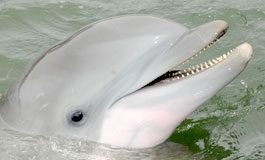
Our Mission -
Through education, research and rescue, Dolphin Research Center promotes peaceful coexistence,
cooperation and communication between marine mammals, humans and the environment we share with
the well being of DRC's animals taking precedence.
